
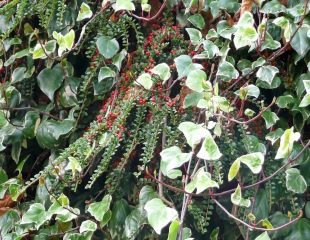
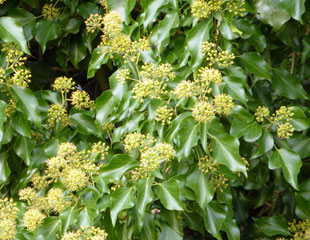
How to Grow English Ivy - Hedera Helix
Ivy has so much going for it. It climbs, it winds, it is good for ground cover. Ivy is tough, tolerant of all growing conditions, self clinging and great for wildlife.
Ivy will grow in difficult places, on poor soils, at the base of a wall, over sheds and shady corners. It will climb up wood fences, brick and stone walls, up pillars, trellis and trees. Many Ivies are shade tolerate, even of dry shade, which makes them especially useful. Variegated varieties brighten up dark corners. Ivy gets overlooked as a climbing plant, but in the right spot it can look very stylish, understated, but classic.
Also, despite its modest appearance, English Ivy is great for wildlife. It provides nectar, pollen and berries when food is short in autumn and winter, and shelter for birds, bats, insects and small mammals.
Ivy takes about a year to get established. Only mature Ivy plants flower as in the image right.
Illustrated above are: left, Ivy covering a wall, centre Ivy grown with Cotoneaster a tough, grow anywhere combination, and right, a mature English Ivy in flower providing food and shelter more wildlife. The Woodland Trust estimates that English Ivy supports up to 50 species of wildlife.
The RHS has undertaken research ( 2016-2018) about the merits of green facades. This research shows that green facades support more invertebrates, and further that the greater the depth of facade supports even more invertebrates. Most interestingly, that "the greatest abundance of invertebrates was a combination of Hedera helix (common ivy) and H. helix ‘Glacier’."
Generally speaking, Ivy will not damage brickwork in good condition but it can disrupt brickwork, which is in a poor state.
Juvenile v Mature English Ivy
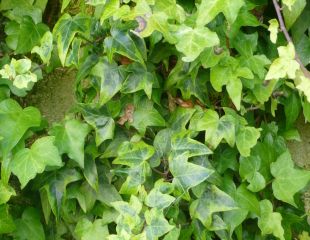
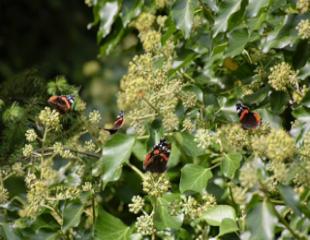
English Ivy can be confusing because it has two distinct growth stages which make it appear as two different plants. Illustrated left is the Juvenille Ivy with the familiar spear-shaped leaves and trailing growth. There is a later phase, when the plant seems to change its shape and style. The leaves no longer have lobed appearance, the climber becomes more shrubby and, importantly for wildlife, it produces flowers. It almost looks like a different plant, so you may not have recognised both as the same Hedera plant.
Much of the information on the internet attributes the change to maturity. Commonly, it is stated that at around 10 years, the switch from juvenile to adult takes place and that's when the change in shape and form occurs. However, the RHS tells me, in response to my particular enquiry on this point, that is not correct. The change in form is triggered by height of the ground and light. As long as the shrub is growing horizontally, it remains juvenile, but once it finds something to climb up, fence, a tree, it will develop the second stage in terms of leaf shape and habit. It is true to say most of this form of Hedera are growing up mature trees. And at that stage it becomes a magnet for wildlife, especially the late summer flowers.
The mature form is sold as Hedera helix 'Arborescens' and there are only a few retailers
Regular pruning can maintain the plant in its juvenile stage. If you want wildlife, let it flourish and it will amaze you with the number and variety of pollinators, insects, bees, butterflies which will flock to the flowers in autumn.
Some plants, as illustrated below, will show both types of leaves. The juvenile leaves will often appear around the base with the mature leaves further up.
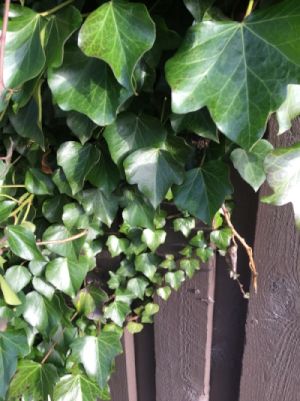
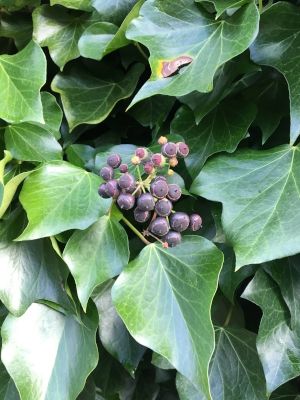
How to prune English Ivy
Ivy is easy to prune and will recover from a hard renovative prune if it has become overgrown. Simply prune into shape mid spring. It is a good idea to prune out any reversionary growth in the variegated varieties, to prevent it from spreading. (Reversion is when a variegated shrub develops green growth)
You can also prune Ivy into topiary shapes and use smaller varieties for baskets and containers.
Good varieties of English Ivy for the garden
Good varieties to grow and some with RHS award:
- Hedera helix glacier has grey/green leaves with cream variation. It has the RHS merit and grows up to 2m which will cover a wall or good as ground cover. (similar to the image top left)
- H. Goldchild has strong yellow gold variations up to 3m
- Hedera colchica (Persian Ivy,) is vigorous with large leaves and will reach up to 10m
- Dentata which has bright green leaves growing up to 5m
- Sulphur Heart which is similar, with brightly variegated leaves and fast growing.
-
Atropurpurea
is a purple leaved Ivy - Goldheart is a green/gold variety with good variegation and grows up to 4m.
As a general rule, the variegated and purple leaved Ivies need more sun, and the green leaved varieties will tolerate more shade.
Ivies vary greatly in their size and vigour, and some are considering vigorous which can be damage and overlay neighbouring plants. Many Ivies sold are fully hardy, but there are some varieties which are not, especially those sold in the summer to go with bedding and in baskets and it is best to check with the label. An explanation of frost hardy.
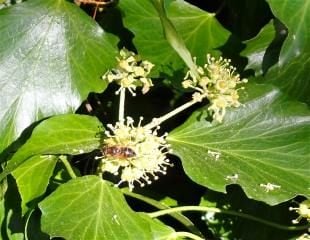
To further demonstrate that English Ivy is pollinator and bee friendly, this image shows a honeybee feeding on the Ivy flowers. The unusual point is that I took this image in November, which is late in the year, which until then had been a mild autumn.
The English Ivy provides late nectar as it flows in the autumn.
updated 30.12.2023

Ivy is a green wheelbarrow plant as it is easy to grow and requires no attention or maintenance.
